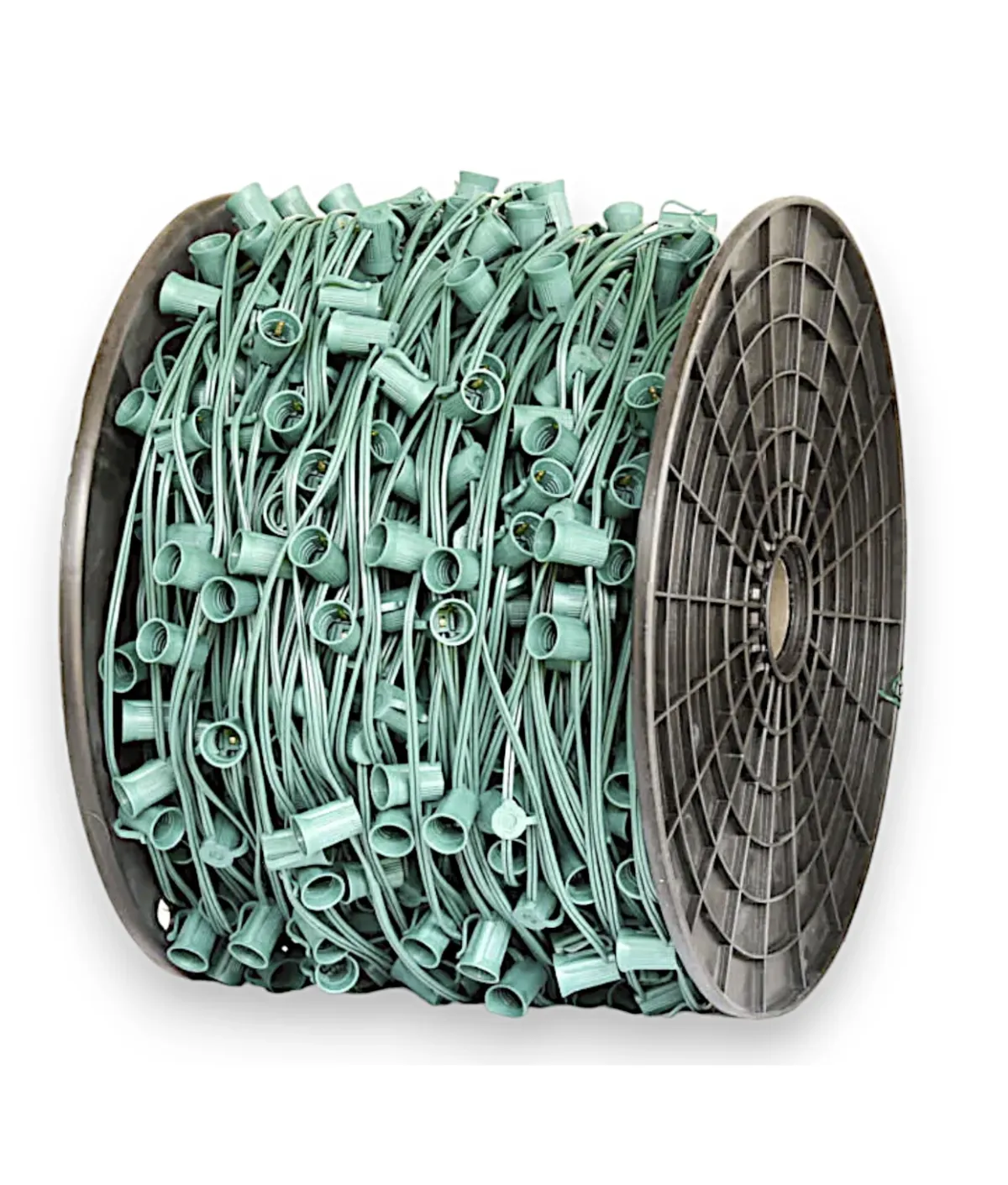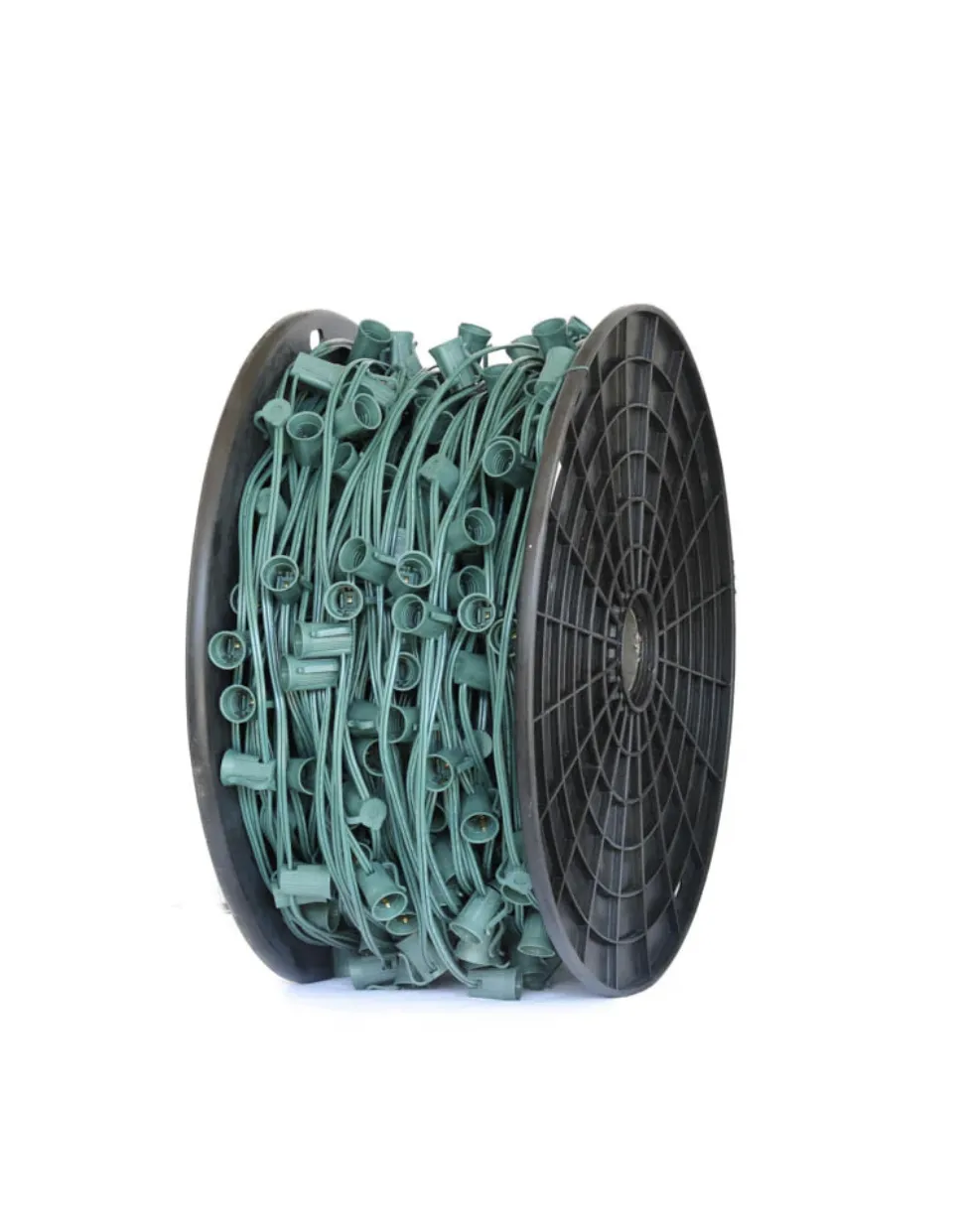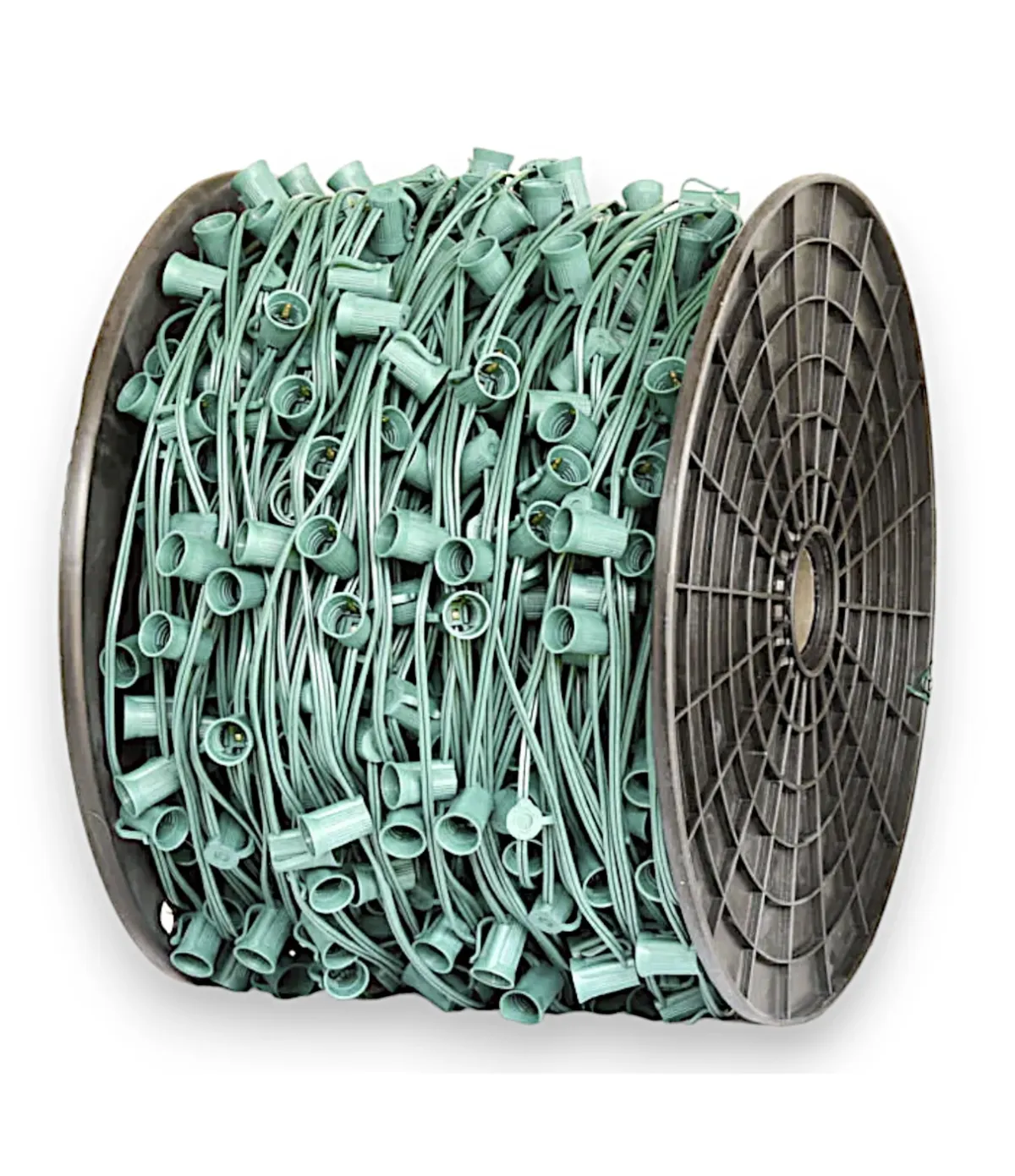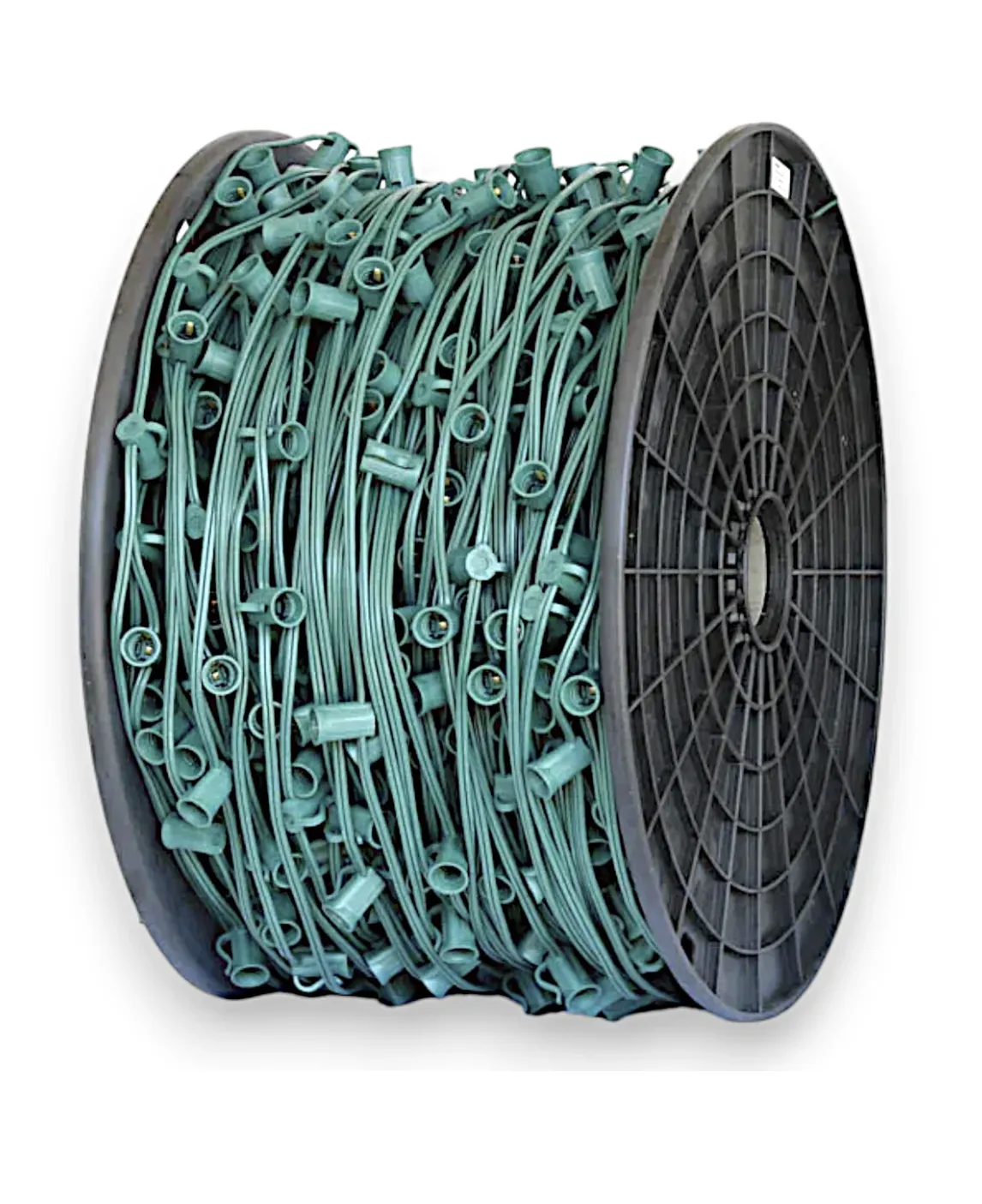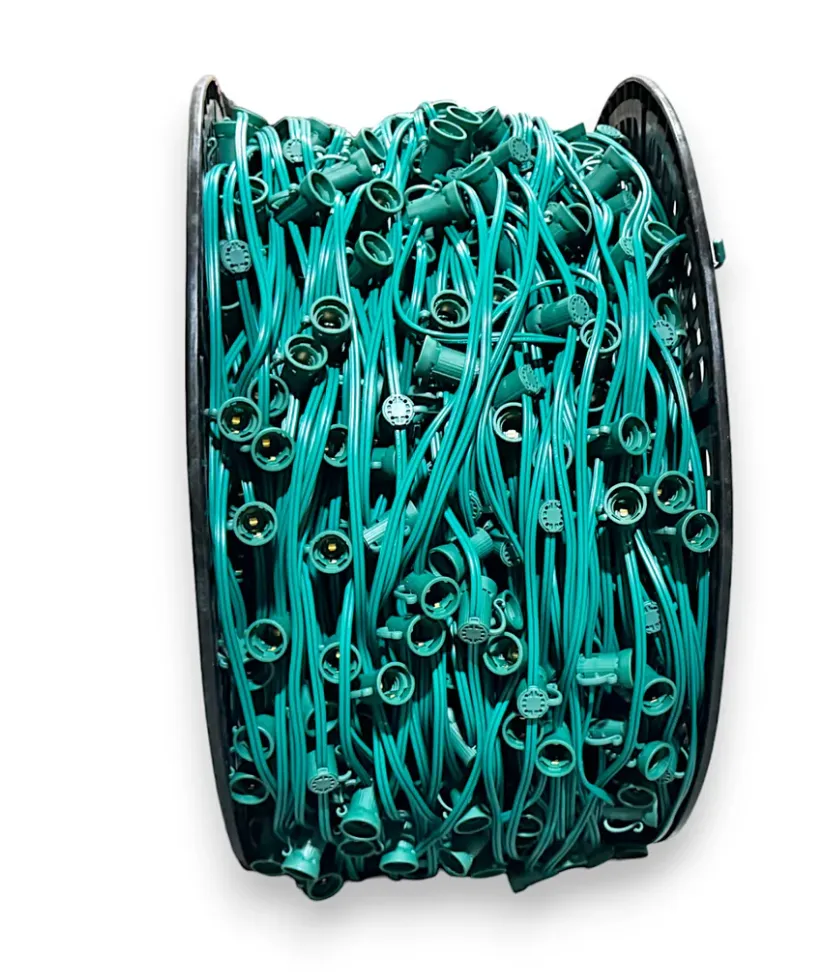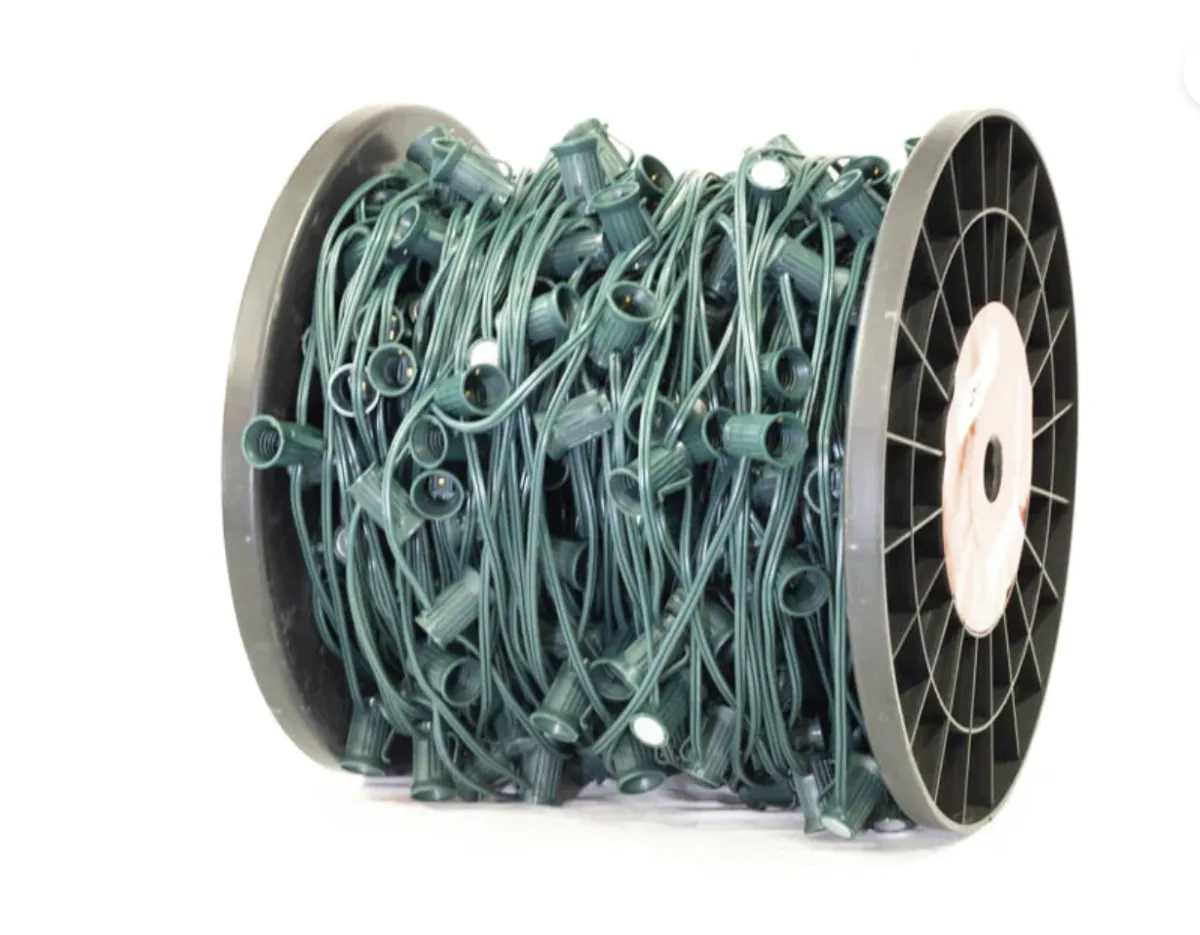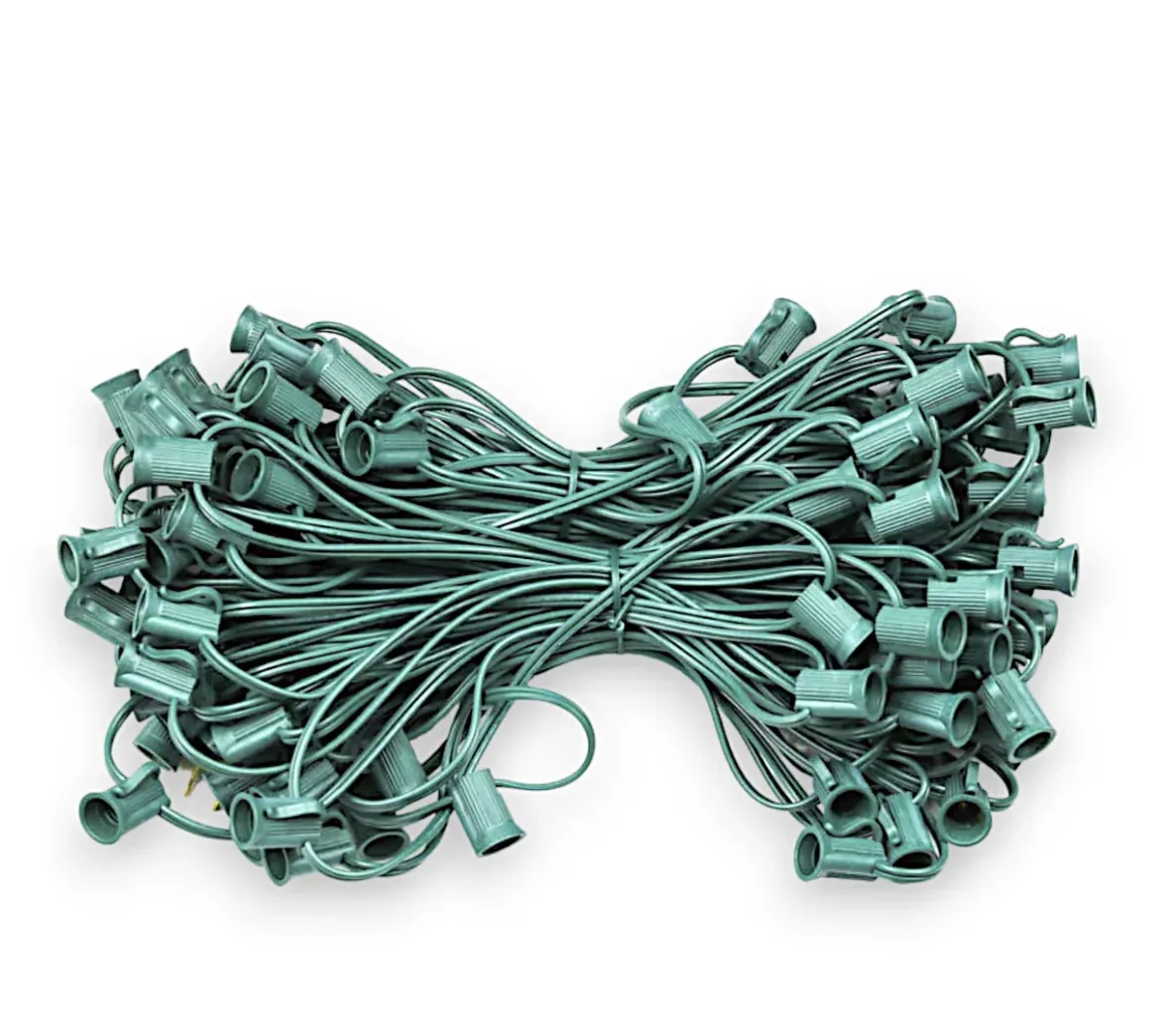C9 & C7 Socket Spools & Stringers
Discover our premium collection of socket wire spools and stringers, the essential foundation for creating stunning light displays. Designed for both professional installers and ambitious homeowners, our range includes bulk C7 and C9 socket wire spools with flexible spacing options, pre-made light stringers for quick setups, and convenient accessories like spool holders. These versatile, durable components are perfect for residential rooflines, enchanting tree displays, and large-scale commercial projects. Suitable for indoor and outdoor use, and compatible with both incandescent and LED bulbs, our professional-grade products offer the quality and flexibility needed to bring your creative lighting visions to life. Explore our selection and elevate your illumination projects with unmatched versatility and reliability.
Socket Spools
C9 1000' Socket Spool
Our C9 1000' Bulk Spool of Socket Wire, available in green or white, offers professional-grade flexibility for custom lighting projects. With spacing options from 6" to 48", it's ideal for both residential rooflines (12-15" spacing) and tree installations (24-48" spacing). The durable SPT-1 wire withstands outdoor conditions and is compatible with both incandescent and LED C9 bulbs. This customizable spool allows for precise length cutting, minimizing waste and maximizing efficiency for high-quality, adaptable lighting displays.
C9 500' Socket Spool
Our C9 500' Bulk Spool of Green Wire, available with 12" (500 sockets) or 15" (400 sockets) spacing, is perfect for professional-grade Christmas lighting installations. Featuring commercial-quality SPT-1, 8-amp wire and durable E17 sockets, this customizable spool is ideal for large-scale outdoor projects. Easily cut to desired lengths and pair with snap-on plugs (sold separately) for tailored lighting solutions in both residential and commercial settings. The 12" spacing offers vibrant, balanced lighting, while the 15" option provides a classic look with fewer bulbs per run.
C9 1000' 12"&15" Socket Wire Spool (SPT-2)
Our C9 1000' Socket Wire Spool (SPT-2) offers professional-grade flexibility with dual 12" and 15" spacing options. This customizable spool features heavy-duty SPT-2 wire for enhanced durability in all weather conditions. The 12" spacing is perfect for dense, vibrant displays on rooflines and pathways, while the 15" option provides a classic look with fewer bulbs per run. Compatible with both incandescent and LED C9 bulbs, this 1000' spool allows for precise cutting to fit any residential or commercial lighting project, ensuring efficient and long-lasting installations.
C7 1000' Green Wire Socket Spool (SPT-2)
Our 1000' bulk spool of green SPT-2 wire features 15" spacing with 1000 C7 sockets, ideal for commercial and residential outdoor displays. This 8-amp (960-watt) commercial-grade wire with Admiral Brand sockets allows for custom-length installations using snap-on plugs (sold separately). Suitable for indoor/outdoor use, it accommodates up to 160 sockets with 5-watt incandescent bulbs or 384 sockets with 1-watt LED bulbs per run. This versatile, durable C7 light line is perfect for creating professional-quality lighting displays in various settings.
C7 1000' Socket Spool
Our C7 1000' Bulk Spool of Socket Wire offers professional-grade flexibility for custom lighting projects. Available in green or white, with spacing options from 12" to 36", it's ideal for both residential rooflines (12-15" spacing) and tree installations (24-36" spacing). The durable SPT-1 wire withstands outdoor conditions and is compatible with both incandescent and LED C7 bulbs. This customizable spool allows for precise length cutting, minimizing waste and maximizing efficiency for high-quality, adaptable lighting displays in various settings.
C9/C7 500' Magnetic Spool
The Fastest Way to Install Holiday Lights on Metal Surfaces. Save time and effort this holiday season with Magnetic Spools. Designed for quick and easy installation, these magnetic spools are perfect for decorating your home or office building. The magnetic sockets eliminate the need for traditional mounting clips, making your installations faster and more efficient. Whether you’re lining rooflines, gutters, or fences, these spools are ideal for any surface where ferrous metal is present.
Available in 500' & 250', 12" or 15" Spacing.
Socket Wire Stringers
C9 12" Spacing Socket Wire Stringers
Our 25', 50' or 100' Holiday Light String features professional-grade, UV-protected 18-gauge wire with sockets spaced 12" apart. Designed for both indoor and outdoor use, these UL-recognized strings offer 5 Amp capacity SPT-1 insulation and durable sockets with weep holes for all-weather performance. Compatible with E12 Candelabra base bulbs (C7, C9, G30; sold separately), these versatile strings allow end-to-end connectivity for extended displays. Perfect for holiday decorations, event lighting, and year-round use in residential and commercial settings. Available in Green, White, Brown and Black.
C7 12" Spacing Socket Wire Stringers
Our professional-grade 25', 50' or 100' light string features sockets spaced 12" apart, perfect for commercial and residential decorators. Designed for both indoor and outdoor use, it's compatible with incandescent or LED C7, G30, and G40 bulbs (sold separately). The SPT-1 insulated wire offers 5 Amp capacity and includes weep-hole sockets for all-weather performance. With male and female plugs for end-to-end connections, these UL-recognized strings can handle up to 480 watts per run. Ideal for holiday displays, patio lighting, and year-round events, these durable strings ensure long-lasting, brilliant illumination for any occasion. Available in Green, White, Brown and Black.
Frequently Asked Questions
What's the difference between socket wire spools and stringers?
cket wire spools are bulk reels of wire with sockets at regular intervals, allowing for custom-length cuts. Stringers are pre-cut lengths of socket wire, typically with plugs attached, ready for immediate use.
Can I use the same socket wire for both C7 and C9 bulbs?
No, C7 and C9 bulbs require different socket sizes. Always check the product specifications to ensure you're using the correct socket wire for your chosen bulb type.
How do I determine the right spacing for my project?
Common spacings are 12", 15", and 24". Use closer spacing (12"-15") for dense, vibrant displays on rooflines or fences. Wider spacing (24" or more) works well for tree wrapping or creating a more subtle effect.
Are these socket wires suitable for outdoor use?
Most of our socket wires are rated for both indoor and outdoor use. Look for products labeled as "weatherproof" or "outdoor-rated" for the best durability in external conditions.
How many bulbs can I safely connect on a single run?
This depends on the wire's amperage rating and the wattage of your bulbs. For example, on an 8-amp wire, you can typically run up to 160 sockets with 5-watt incandescent bulbs or 384 sockets with 1-watt LED bulbs. Always check the product specifications and local electrical codes for safe operation.
Discover Expert Tips on Our Blog

The Most Dangerous Christmas Light Install Mistakes
In the pressure washing and Christmas light installation industry, safety isn't just a buzzword—it's a matter of life and death. As someone who has witnessed numerous accidents and their aftermath, I want to address the critical importance of safety practices in our industry. Recent incidents, including several falls and tragic accidents, have highlighted the urgent need for better safety awareness and implementation.
The Real Cost of Cutting Corners
Let's talk numbers: A back surgery can cost upwards of $180,000 for the first procedure alone, with follow-up surgeries potentially reaching $260,000. But the real cost isn't just financial—it's the impact on your life, your family, and your ability to work. As the saying goes, "Falling won't kill you, but that sudden stop will." This harsh reality is why we need to take safety seriously, whether we're working one story up or three.
Essential Safety Equipment
Ladder Safety
1. Ladder Stabilizers: These aren't optional extras—they're essential safety equipment. A ladder standoff or stabilizer can prevent the ladder from kicking out, one of the most common causes of falls.
2. Proper Angle and Positioning:
- Maintain a 75-degree angle (the optimal ladder angle)
- Extend three rungs above the roof
- Ensure the ladder is on level ground
- Use ladder leg adjusters for uneven surfaces
3. Three Points of Contact: Always maintain three points of contact when climbing—this means two hands and one foot, or two feet and one hand should be in contact with the ladder at all times.
Roof Safety
1. Pitch Hoppers: While useful, these can give a false sense of security. Remember: you're either all on or all off—never straddle or partially use these tools.
2. Harness Systems:
- Basic harness kit ($100-150)
- Goat Assist ($500-600)
- Ridge Pro ($600)
- Professional rope systems
3. Cougar Paws: Specialized footwear for better roof traction.
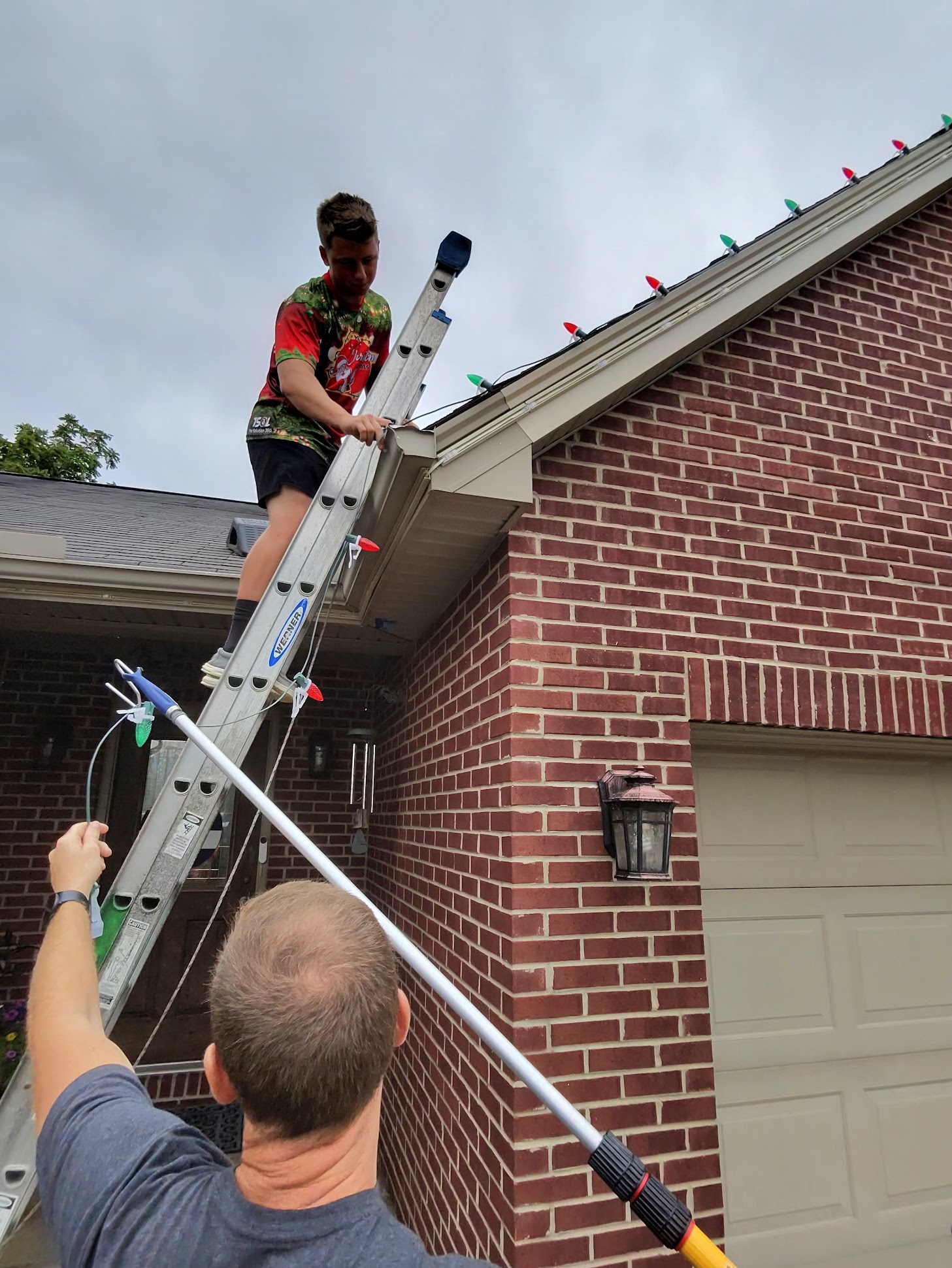
Electrical Safety in Christmas Light Installation
Electrical safety is just as crucial as fall protection. Here are key guidelines:
1. One Male End Rule: Only one male plug per line—you can have multiple female connections, but never multiple male ends.
2. Proper Connection Protection:
- Use female ends at termination points
- Position connections to allow water drainage
- Avoid using tape on connections as it can trap water
- Use clips to secure connections away from gutters
3. Power Management:
- Use remote controls for testing
- Always cut wires with power off
- Test installations systematically to avoid multiple trips
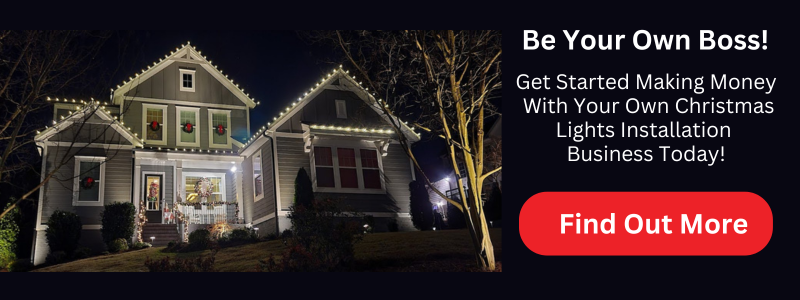
Best Practices for Working at Height
Before You Start
1. Look Up: Always check for power lines before setting up ladders or equipment.
2. Sound the Roof: Check for weak spots or rotted areas before walking on any roof.
3. Have a Fall Plan: Know where you could catch yourself or what you might grab if you start to fall.
During Work
1. Never Work Alone: Always have someone who can call 911 if needed. A real-life example: a pressure washer fell from a 6-foot deck, broke his back, and had to crawl to his truck to call for help because he was working alone.
2. Keep Your Phone on You: Carry your cell phone in a secure pocket while working.
3. Weather Awareness: Avoid roof work in wet, icy, or frosty conditions. Even morning dew can make surfaces dangerously slick.
Training and Certification
Investment in safety training is far less expensive than hospital bills or funeral costs. Consider:
1. OSHA 10 Certification: Especially important for rope and harness work.
2. Professional Safety Courses: Many companies offer specialized training for roof work and fall protection.
3. Regular Safety Meetings: If you have employees, document safety training and have workers sign off on procedures.
Special Considerations
Weather Conditions
- Never work on icy or frost-covered roofs
- Be aware that morning dew can create slippery conditions
- Wind can make ladder work particularly dangerous
Employee Safety
Remember that employees often try to exceed what they see you do—if you work unsafely, they may take even bigger risks. Set a good example by always following safety protocols, even for quick tasks.
Equipment Maintenance
- Regularly inspect all safety equipment
- Replace any worn or damaged items immediately
- Keep ladders clean and in good condition
- Check electrical equipment for wear or damage
Common Mistakes to Avoid
1. Overconfidence: Many accidents happen to experienced workers who become too comfortable with risks.
2. Rushing: Never compromise safety to complete a job faster or to squeeze in one more task.
3. Inadequate Equipment: Don't try to make do with improper tools or worn-out safety gear.
4. Working Alone: Always have a spotter for ladder work and someone available to call for help if needed.

The Business Case for Safety
While safety equipment and proper training represent an investment, consider the alternatives:
- Hospital bills ranging from tens to hundreds of thousands of dollars
- Lost work time and income
- Potential business closure due to injury
- Legal liability and increased insurance costs
Moving Forward: Building a Culture of Safety
As our industry continues to grow, with more people entering both pressure washing and Christmas light installation businesses, it's crucial to establish and maintain a strong safety culture. This means:
1. Regular Training: Invest in ongoing safety education for yourself and your team.
2. Proper Equipment: Budget for and maintain quality safety gear.
3. Clear Procedures: Establish and document safety protocols for all aspects of your work.
4. Zero Tolerance: Never compromise on safety for convenience or profit.
Remember, no job is worth risking your life or long-term health. The few extra minutes it takes to set up proper safety equipment, or the additional cost of quality safety gear, is insignificant compared to the potential consequences of an accident. As we continue to see accidents in our industry, let's commit to making safety our top priority and looking out for one another. After all, the best job is one that you can walk away from at the end of the day.
Whether you're new to the industry or a seasoned professional, take this message to heart: Safety isn't just about following rules—it's about going home to your family every night. Make the commitment to safety today, because tomorrow might be too late.

What is the correct angle for positioning a ladder?
A: The optimal ladder angle is 75 degrees. A good rule of thumb is the "one-quarter rule" - the ladder's base should be placed one-quarter of the ladder's working length away from the wall. For example, if you're climbing to a 12-foot height, the base of the ladder should be 3 feet from the wall. Additionally, make sure the ladder extends at least three rungs above the roof line for safe access.
Do I really need a ladder stabilizer?
A: Yes, ladder stabilizers are essential safety equipment, not optional extras. They prevent the ladder from kicking out, which is one of the most common causes of falls. A ladder stabilizer (or standoff) also helps protect gutters and provides better stability when accessing the roof. The cost of a stabilizer is minimal compared to potential medical bills from a fall.
When should I use a safety harness on a roof?
A: You should consider using a safety harness any time you're working on a roof, regardless of the pitch or height. While there's no specific pitch requirement that mandates harness use, remember that falls can happen even on seemingly "safe" low-slope roofs. A basic harness kit costs $100-150, a small investment compared to the potential cost of injury. More advanced systems like the Goat Assist ($500-600) or Ridge Pro ($600) provide additional safety features.
What's the proper way to handle electrical connections for Christmas lights?
A: Follow these key rules for electrical safety:
- Always have only ONE male plug per line
- Use female ends at termination points
- Position connections pointing down and away from gutters to allow water drainage
- Never use tape on connections as it can trap water
- Use clips to secure connections away from gutters
- Always cut wires with the power off
- Use a remote control for testing installations
Why shouldn't I work alone on ladder or roof jobs?
A: Working alone creates significant risks. If you fall or get injured, you need someone to call 911 immediately. There's a real example of a pressure washer who fell from just a 6-foot deck, broke his back, and had to crawl to his truck to call for help because he was working alone. Your spotter can also foot the ladder, watch for hazards, and help with equipment. Always have someone who can call for emergency help if needed.
What should I check before getting on a roof?
A: Before accessing any roof:
1. Look up to check for power lines
2. Sound the roof to check for weak spots or rotted areas
3. Assess weather conditions - avoid wet, icy, or frosty conditions
4. Ensure your ladder is properly positioned and secured
5. Have your safety equipment ready and properly fitted
6. Make sure you have a spotter present
7. Keep your phone on you for emergencies
What are the most common safety mistakes people make?
A: The most frequent safety mistakes include:
- Overconfidence/complacency, especially among experienced workers
- Rushing to complete jobs or "just one more task"
- Using inadequate or worn-out safety equipment
- Working alone without a spotter
- Not maintaining three points of contact on ladders
- Improper ladder positioning
- Not using ladder stabilizers
- Trying to reach too far instead of moving the ladder
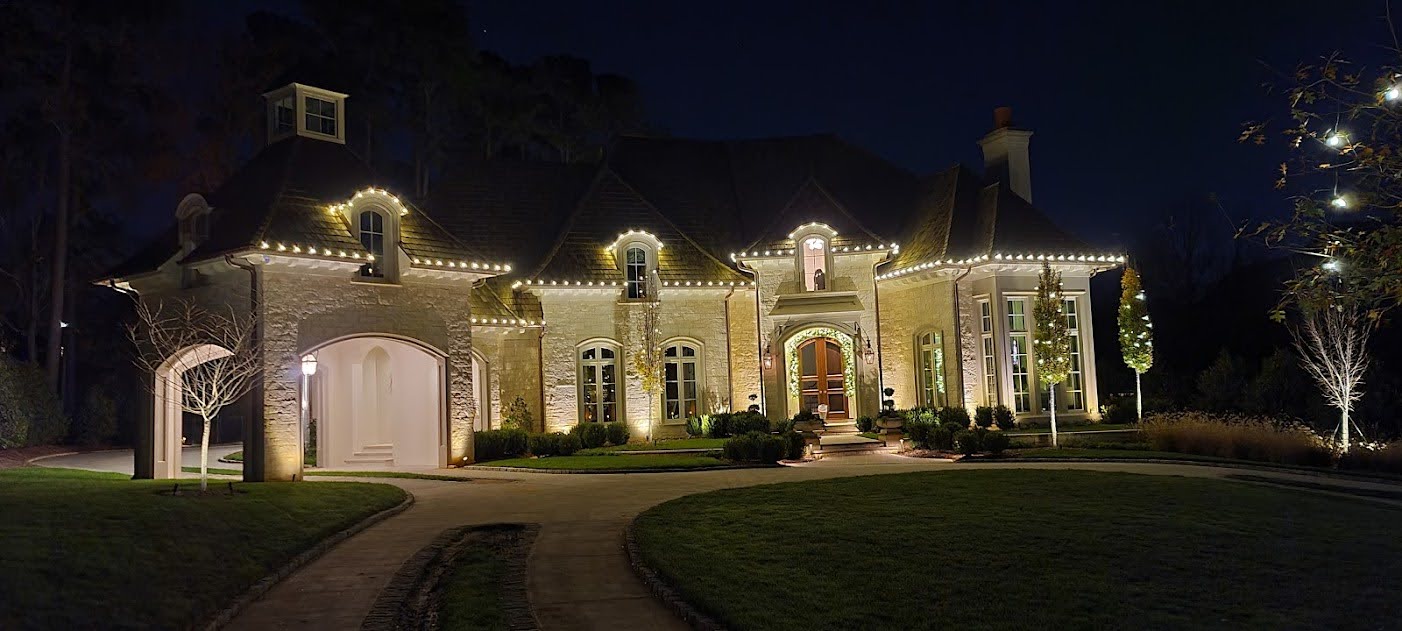
How should I store and maintain my safety equipment?
A: Proper maintenance of safety equipment is crucial:
- Regularly inspect all safety equipment before each use
- Replace any worn or damaged items immediately
- Keep ladders clean and free from debris
- Store equipment in a dry place
- Document inspections and repairs
- Never use damaged equipment "just one more time"
- Follow manufacturer guidelines for replacement schedules
What safety training should I invest in?
A: Recommended safety training includes:
- OSHA 10 certification, especially if using rope and harness systems
- Professional safety courses specific to roof work
- Fall protection training
- Ladder safety certification
- Electrical safety training for Christmas light installation
- Regular safety meetings and updates for teams
- First aid and emergency response training
How much should I budget for safety equipment?
A: While safety equipment requires an investment, consider these typical costs versus potential medical bills:
- Basic harness kit: $100-150
- Goat Assist: $500-600
- Ridge Pro: $600
- Ladder stabilizers: $50-100
- Quality extension ladder: $200-400
- Cougar Paws (roof boots): $100-200
- Remote power controls: $50-100
- First aid kits: $50-100
Remember: A single back surgery can cost $180,000 or more. Even the most expensive safety equipment is a bargain compared to medical bills, lost work time, or worse. Investment in proper safety equipment should be considered a necessary business expense, not an optional extra.
Copyright ©2024 All Right Reserved website designed by christmaslights.io
Terms of Service / Privacy Policy
Have questions or need assistance?
Contact us at (855)619-LITE


